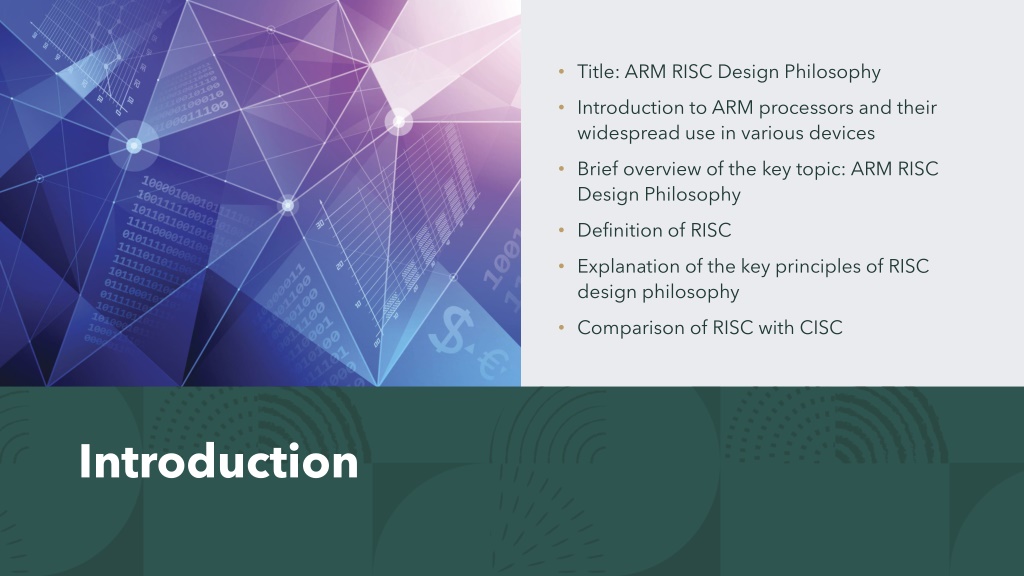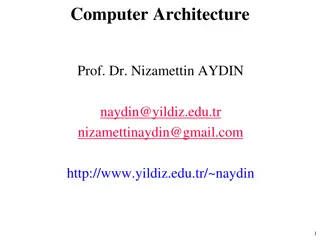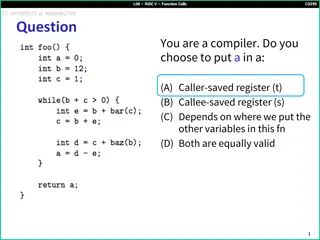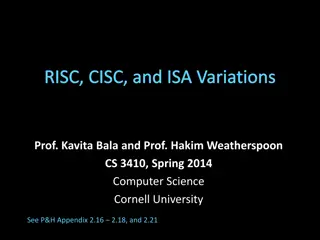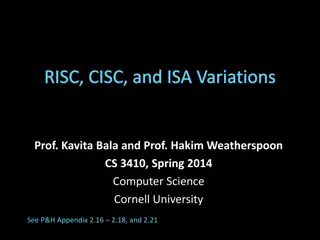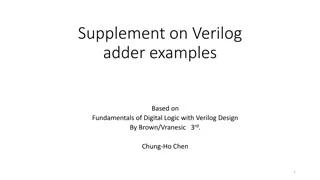ARM RISC Design Philosophy and Its Impact
Delve into the world of ARM processors, exploring the RISC design philosophy that underpins their efficiency and widespread application. Learn about key principles, compare RISC with CISC, and discover how ARM's simplicity, orthogonality, and efficient architecture contribute to its dominance in mobile devices, IoT, and beyond. Explore the diverse applications and future prospects of ARM processors.
Download Presentation

Please find below an Image/Link to download the presentation.
The content on the website is provided AS IS for your information and personal use only. It may not be sold, licensed, or shared on other websites without obtaining consent from the author.If you encounter any issues during the download, it is possible that the publisher has removed the file from their server.
You are allowed to download the files provided on this website for personal or commercial use, subject to the condition that they are used lawfully. All files are the property of their respective owners.
The content on the website is provided AS IS for your information and personal use only. It may not be sold, licensed, or shared on other websites without obtaining consent from the author.
E N D
Presentation Transcript
Title: ARM RISC Design Philosophy Introduction to ARM processors and their widespread use in various devices Brief overview of the key topic: ARM RISC Design Philosophy Definition of RISC Explanation of the key principles of RISC design philosophy Comparison of RISC with CISC Introduction
Brief overview of ARM architecture and its significance Mention of ARM's dominance in mobile devices, embedded systems, and IoT Simplicity: Focus on a small set of simple and optimized instructions Orthogonality: Consistent registers and uniform instruction format Uniform Register File: Data and address operations using the same set of registers Load-Store Architecture: Memory access limited to load and store instructions Fixed-Length Instruction Encoding: Simplifies fetching and decoding Pipelining and Instruction-Level Parallelism: Efficient execution and performance Improved performance through efficient instruction execution Simplicity and orthogonality leading to easier design and optimization ARM Architecture Overview
ARM Architecture Overview Reduced power consumption and energy efficiency Compatibility and ease of programming across different ARM-based systems
Showcase the diverse range of applications where ARM processors are used Examples: Mobile devices, embedded systems, IoT, automotive, etc Applications and Impact Discuss the impact of ARM RISC design philosophy on these applications
Recap of the key points discussed in the presentation Conclusio n Reinforce the significance of ARM RISC design philosophy Conclude with the impact and future prospects of ARM processors
Title: ARM7 Fundamentals, Data Flow Model, and Programmer's Model Introduction to ARM7 and its significance in embedded systems Brief overview of the key topics: ARM7 Fundamentals, Data Flow Model, and Programmer's Model
Overview of ARM architecture and its various versions Overview ARM7 Architecture Overview Highlight the significance of ARM7 in the ARM architecture family Highlight Mention the applications and industries where ARM7 processors are commonly used Mention
Introduction to the fundamental features of the ARM7 processor 32-bit RISC architecture ARM7 Fundamentals Thumb instruction set for improved code density Pipelining for efficient instruction execution Power-saving modes and features
Explanation of the data flow model in ARM7 processors Overview of the data path and control flow in the processor Mention of key components like the ALU , registers, and data transfer paths Illustrate the data flow model with a simple diagram Introduction to the ARM7 Programmer's Model Overview of the key registers and their functions General-Purpose Registers Program Counter Stack Pointer Current Program Status Register Data Flow Model
Explanation of the different execution modes available in ARM7 processors User mode Supervisor mode Interrupt mode Abort mode System mode Slide 4: Data Flow Model
Overview of the memory organization in ARM7-based systems Explanation of memory regions such as code, data, stack, and peripherals Memory Organization Mention of the memory addressing modes supported by ARM7 processors
Exception Handling Overview of exception handling in ARM7 processors Explanation of exception vectors and interrupt handlers Mention of different types of exceptions, such as interrupts, faults, and aborts Recap of the key points discussed in the presentation Reinforce the significance of ARM7 fundamentals, data flow model, and programmer's model Conclude with the impact and applications of ARM7 processors
